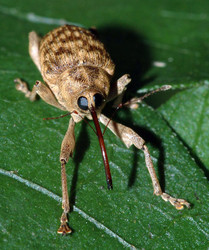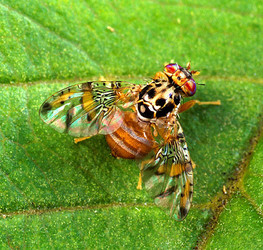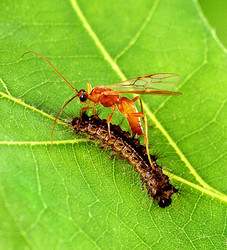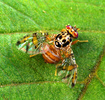Endopterygota
Insects with complete metamorphosis



This tree diagram shows the relationships between several groups of organisms.
The root of the current tree connects the organisms featured in this tree to their containing group and the rest of the Tree of Life. The basal branching point in the tree represents the ancestor of the other groups in the tree. This ancestor diversified over time into several descendent subgroups, which are represented as internal nodes and terminal taxa to the right.

You can click on the root to travel down the Tree of Life all the way to the root of all Life, and you can click on the names of descendent subgroups to travel up the Tree of Life all the way to individual species.
For more information on ToL tree formatting, please see Interpreting the Tree or Classification. To learn more about phylogenetic trees, please visit our Phylogenetic Biology pages.
close boxIntroduction
Endopterygotes are those insects with distinctive larval, pupal, and adult stages. Their name (endo = within, pterygos = wing) refers to the fact that in later immature stages the wing buds are not evident externally, but instead the future wing tissues are entirely internalized; they make their first external appearance in the penultimate (pupal) stage. In contrast, other winged insects (for example, bugs) have external wing buds in instars before the penultimate.
Another name for this group is Holometabola, referring to the "complete metamorphosis" of the species; that is, the dramatic changes between larval, pupal, and adult stages.
Four of the five largest orders of insects belong to this group (Coleoptera, Hymenoptera, Lepidoptera, and Diptera).
References
Aspöck, U. 2002. Phylogeny of the Neuropterida (Insecta: Holometabola). Zoologica Scripta 31:51-56.
Beutel, R. G. and S. N. Gorb. 2001. Ultrastructure of attachment specializations of hexapods, (Arthropoda): evolutionary patterns inferred from a revised ordinal phylogeny. Journal of Zoological Systematics and Evolutionary Research 39:177-207.
Beutel, R. G. and H. Pohl. 2006. Endopterygote systematics – where do we stand and what is the goal (Hexapoda, Arthropoda)? Systematic Entomology 31(2):202-219.
Bonneton, F., F. G. Brunet, J. Kathirithamby, V. Laudet. 2006. The rapid divergence of the ecdysone receptor is a synapomorphy for Mecopterida that clarifies the Strepsiptera problem. Insect Molecular Biology 15(3):351-362.
Castro, L. R. and M. Dowton. 2005. The position of the Hymenoptera within the Holometabola as inferred from the mitochondrial genome of Perga condei (Hymenoptera: Symphyta: Pergidae). Molecular Phylogenetics and Evolution 34(3):469-479.
Chalwatzis, N., J. Hauf, Y. V. D. Peer, R. Kinzelbach, and F. K. Zimmerman. 1996. 18S ribosomal RNA genes of insects: primary structure of the genes and molecular phylogeny of the Holometabola. Annals of the Entomological Society of America 89:788-803.
Dallai, R., P. Lupetti, B. A. Afzelius, et al. 2003. Sperm structure of Mecoptera and Siphonaptera (Insecta) and the phylogenetic position of Boreus hyemalis. Zoomorphology 122(4): 211-220.
Haring, E. and U. Aspöck. 2004. Phylogeny of the Neuropterida: a first molecular approach. Systematic Entomology 29(3):415-430.
Hörnschemeyer, T. 2002. Phylogenetic significance of the wing-base of the Holometabola (Insecta). Zoologica Scripta 31:17-29.
Huelsenbeck, J. P. 1998. Systematic bias in phylogenetic analysis: is the Strepsiptera problem solved? Systematic Biology 47:519-537.
Hwang, U. W., W. Kim, D. Tautz, and M. Friedrich. 1998. Molecular phylogenetics at the Felsenstein zone: approaching the Strepsiptera problem using 5.8S and 28S rDNA sequences. Molecular Phylogenetics and Evolution 9:470-480.
Krauss, V., C. Thummler, F. Georgi, J. Lehmann, P. F. Stadler, and C. Eisenhardt. 2008. Near intron positions are reliable phylogenetic markers: An application to holometabolous insects. Molecular Biology and Evolution 25:821-830; doi:10.1093/molbev/msn013.
Kristensen, N. P. 1997. Early evolution of the Lepidoptera+ Trichoptera lineage: phylogeny and the ecological scenario. Mémoires du Muséum National d'Histoire Naturelle 173:253-271.
Kristensen, N. P. 1999. Phylogeny of endopterygote insects, the most successful lineage of living organisms. European Journal of Entomology 96:237-253.
Kukalová-Peck, J. and R. Willmann. 1990. Lower Permian "mecopteroid-like" insects from Central Europe (Insecta, Endopterygota). Canadian Journal of Earth Sciences 27:459-468.
Meier, R. and G. S. Lim. 2009. Conflict, convergent evolution, and the relative importance of immature and adult characters in endopterygote phylogenetics. Annual Review of Entomology 54:85-104.
Pashley, D. P., B. A. McPheron, and E. A. Zimmer. 1993. Systematics of holometabolous insect orders based on 18S ribosomal RNA. Molecular Phylogenetics and Evolution 2:132-142.
Sehnal, F, P. Švácha, and J. Zrzavy. 1996. Evolution of insect metamorphosis. Pages 3–58 in Metamorphosis, Postembryonic Reprogramming of Gene Expression in Amphibian and Insect Cells. L. I. Gilbert, J. R. Tata, and B. G. Atkinson, eds. Academic Press, San Diego.
Truman, J. W. and L. M. Riddiford. 1999. The origins of insect metamorphosis. Nature 401(6752):447-452.
Wheeler, W. C., M. Whiting, Q. D. Wheeler, and J. M. Carpenter. 2001. The phylogeny of the extant hexapod orders. Cladistics 17:113-169.
Whiting, M. F. 1998. Long-branch distraction and the Strepsiptera. Systematic Biology 47:134-138.
Whiting, M. F. 1998. Phylogenetic position of the Strepsiptera: review of molecular and morphological evidence. International Journal of Insect Morphology and Embryology 27:53-60.
Whiting, M. F. 2002. Phylogeny of the holometabolous insect orders: molecular evidence. Zoologica Scripta 31:3-15.
Whiting, M. F. 2002. Mecoptera is paraphyletic: multiple genes and phylogeny of Mecoptera and Siphonaptera. Zoologica Scripta 31:93-104.
Whiting, M. F. 2002. Phylogeny of the holometabolous insect orders based on 18S ribosomal data: when bad things happen to good data. In: R. DeSalle, G. Giribet, and W. C. Wheeler (Eds.) Molecular Systematics and Evolution: Theory and Practice. Birkhäuser Verlag AG, Basel.
Whiting, M. F., J. C. Carpenter, Q. D. Wheeler, and W. C. Wheeler. 1997. The Strepsiptera problem: phylogeny of the holometabolous insect orders inferred from 18S and 28S ribosomal DNA sequences and morphology. Systematic Biology 46:1-68.
Wootton, R. J. 2002. Design, function and evolution in the wings of holometabolous insects. Zoologica Scripta 31:31-40.
Title Illustrations

| Scientific Name | Curculio spp. |
|---|---|
| Location | United States |
| Sex | Male |
| Source | #1366015 |
| Source Collection | Bugwood Network/Forestry Images |
| Image Use |
 This media file is licensed under the Creative Commons Attribution License - Version 3.0. This media file is licensed under the Creative Commons Attribution License - Version 3.0.
|
| Copyright | © Susan Ellis |
| Scientific Name | Ceratitis capitata |
|---|---|
| Comments | Mediterranean fruit fly |
| Creator | Photograph by Scott Bauer |
| Acknowledgements | courtesy USDA Agricultural Research Service |
| Specimen Condition | Live Specimen |
| Sex | Male |
| Scientific Name | Aleiodes indiscretus, Lymantria dispar |
|---|---|
| Comments | Aleiodes indiscretus wasp parasitizing a gypsy moth caterpillar (Lymantria dispar). |
| Creator | Photograph by Scott Bauer |
| Specimen Condition | Live Specimen |
| Source Collection | Agricultural Research Service Image Gallery |
About This Page
Page copyright © 1995
 Page: Tree of Life
Endopterygota. Insects with complete metamorphosis.
The TEXT of this page is licensed under the
Creative Commons Attribution-NonCommercial License - Version 3.0. Note that images and other media
featured on this page are each governed by their own license, and they may or may not be available
for reuse. Click on an image or a media link to access the media data window, which provides the
relevant licensing information. For the general terms and conditions of ToL material reuse and
redistribution, please see the Tree of Life Copyright
Policies.
Page: Tree of Life
Endopterygota. Insects with complete metamorphosis.
The TEXT of this page is licensed under the
Creative Commons Attribution-NonCommercial License - Version 3.0. Note that images and other media
featured on this page are each governed by their own license, and they may or may not be available
for reuse. Click on an image or a media link to access the media data window, which provides the
relevant licensing information. For the general terms and conditions of ToL material reuse and
redistribution, please see the Tree of Life Copyright
Policies.
Citing this page:
Tree of Life Web Project. 1995. Endopterygota. Insects with complete metamorphosis. Version 01 January 1995 (under construction). http://tolweb.org/Endopterygota/8243/1995.01.01 in The Tree of Life Web Project, http://tolweb.org/











 Go to quick links
Go to quick search
Go to navigation for this section of the ToL site
Go to detailed links for the ToL site
Go to quick links
Go to quick search
Go to navigation for this section of the ToL site
Go to detailed links for the ToL site